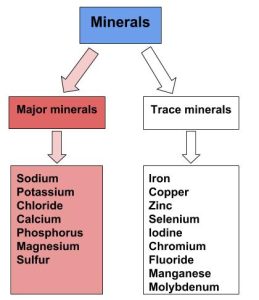University of Hawai‘i at Mānoa Food Science and Human Nutrition Program and Human Nutrition Program
He pūko`a kani `āina
A coral reef strengthens into land.

Learning Objectives
By the end of this chapter you will be able to:
- Describe the functional role, intake recommendations and sources of major minerals
Similarly to vitamins, minerals are essential to human health and can be obtained in our diet from different types of food. Minerals are abundant in our everyday lives. From the soil in your front yard to the jewelry you wear on your body, we interact with minerals constantly. There are 20 essential minerals that must be consumed in our diets to remain healthy. The amount of each mineral found in our bodies vary greatly and therefore, so does consumption of those minerals. When there is a deficiency in an essential mineral, health problems may arise.
Major minerals are classified as minerals that are required in the diet each day in amounts larger than 100 milligrams. These include sodium, potassium, chloride, calcium, phosphorus, magnesium, and sulfur. These major minerals can be found in various foods. For example, in Guam, the major mineral, calcium, is consumed in the diet not only through dairy, a common source of calcium, but also through through the mixed dishes, desserts and vegetables that they consume. Consuming a varied diet significantly improves an individual’s ability to meet their nutrient needs. [1]
Figure 10.1 The Major Minerals

Bioavailability
Minerals are not as efficiently absorbed as most vitamins and so the bioavailability of minerals can be very low. Plant-based foods often contain factors, such as oxalate and phytate, that bind to minerals and inhibit their absorption. In general, minerals are better absorbed from animal-based foods. In most cases, if dietary intake of a particular mineral is increased, absorption will decrease. Some minerals influence the absorption of others. For instance, excess zinc in the diet can impair iron and copper absorption. Conversely, certain vitamins enhance mineral absorption. For example, vitamin C boosts iron absorption, and vitamin D boosts calcium and magnesium absorption. As is the case with vitamins, certain gastrointestinal disorders and diseases, such as Crohn’s disease and kidney disease, as well as the aging process, impair mineral absorption, putting people with malabsorption conditions and the elderly at higher risk for mineral deficiencies.
Learning Activities
Technology Note: The second edition of the Human Nutrition Open Educational Resource (OER) textbook features interactive learning activities. These activities are available in the web-based textbook and not available in the downloadable versions (EPUB, Digital PDF, Print_PDF, or Open Document).
Learning activities may be used across various mobile devices, however, for the best user experience it is strongly recommended that users complete these activities using a desktop or laptop computer and in Google Chrome.
- Pobocik RS, Trager A, Monson LM. (2008). Dietary Patterns and Food Choices of a Population Sample of Adults on Guam. Asia Pacific Journal of Clinical Nutrition., 17(1), 94-100. http://apjcn.nhri.org.tw/server/APJCN/17/1/94.pdf. Accessed February 16, 2018. ↵
An essential mineral required in the diet in an amount greater than 100 mg per day.
An element used in the body to promote chemical reactions and help form body structures.
An essential nutrient the body needs in small amounts that aids in maintaining various body processes like fluid balance.
The amount of a dietary nutrient that is absorbed and utilized by the body.

